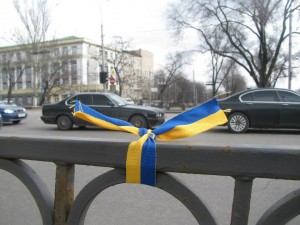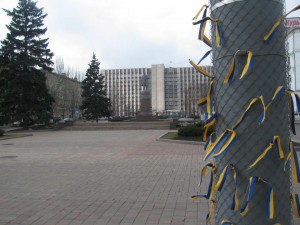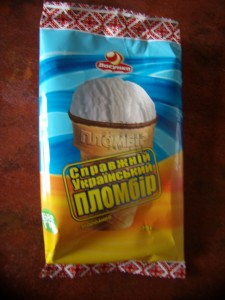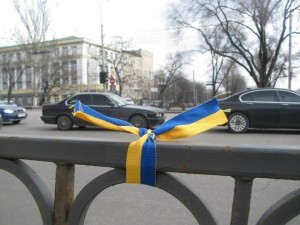17.08.2015. www.delfi.lv, www.lsm.lv

“People, living in the anti-terrorist operation (ATO) zone, often die not being ill, as if their life force has left them”. Such phrase in one of the articles literally caught my eyes. I fully agree with it, everything is exactly like that: because of constant stress and danger waylaying at any moment of their lives, people here become aged and exhausted more rapidly. I appreciate this observation of the author of the article – competent psychologist. The war, going on for already second year, impacts both body and emotional-psychological condition (many people suffer from chronic depression, increased discomposure), and also thoughts (beginning with “everything will be finished soon, and peace will come” and ending with “we have been abandoned here, nobody cares for us, and that will never end”), and habits (for example, while meeting combatants, one has to conceal the real emotions behind neutral expression on face, at a quick glance instantly take notice and remember details of happening; we have to be dressed keeping a low profile).
Not only such things are worth mentioning, but also the mutual support of the people sometimes even not knowing each other, and how much the sense of humour is helpful. Since the firing on the city by combatants (sometimes it is struggle among their internal groups, and sometimes they shoot “on the part of” Ukrainian Army) has become the everyday reality, constant waiting for flying shells, disturbed thoughts like “which place to choose for the bed to avoid as much as possible eventual bomb fragments?” indicate that there is stress stuck deep in the body. And when the phrase “be asleep, they are flying away” from the fresh joke about Donetsk residents who have awaken in the middle of the night from the sound of cannonade, causes laughter (even if only the Donetsk people are laughing), it means that body is still opposing the stress, that people have already been used to life in this frightful lingering situation.
Also the benefits of civilization are very helpful – mobile communication, Internet, social networks, providing the possibility of constant links with relatives and likeminded persons, access to information portals of Ukraine and the World. When intensive fighting is going on, the city residents put information on damages in social networks thereby collecting data on firing and victims, warning about the actual locations at risk. And whatever falsified information is presented by the “DPR’s” (Donetsk People’s Republic) and Russian mass media, there exist evidences of their crimes.
All in all, patriotic activity has been forced to take virtual form. While exchanging opinions in social networks, people often remember the pro-Ukraine meetings in spring 2014 against the war and separatism, especially the huge Ukrainian flag spread over the participants and covering nearly the whole Lenin Square. And the heart is beating more joyfully from that. And many people have already prepared Ukrainian symbols, impatiently waiting for liberation, ready to use them for decorating the city cleaned from the “DPR’s” and Russian filth; it is often discussed what should be done with the bloodstained Lenin Square; and the main question is -how to clear the consciousness of many compatriots from the lie of Russian television which has filled their minds.
The idea has been recently proposed to organize a virtual flash mob – publicizing of pre-war photographs of one’s own and/or the children dressed in Ukrainian national costumes in order to demonstrate that embroidery is not just a short-term kind of fashion (such opinion is sometimes expressed), but Ukraine has always been here, it is here, and it will be here. Many our families have had embroidered national costumes, if not for grownups, then for children surely. Since the very Soviet period, the store “Ukrainian Souvenirs” has been quite popular among both Donetsk citizens and the guests. There has always been a possibility to choose either for oneself or for child some traditional embroidered garment or a modern piece of clothing with elements of national embroidery. The store is situated right opposite to the building of Donetsk Regional Administration occupied by combatants. Of course, they have been unable to endure such neighbourhood, and they removed the word “Ukrainian” being afraid of even the word.
By and large, the active Ukrainian protest was going on during the whole spring of 2014 – marathon of interdenominational prayer, demonstrations „Against the War and Separatism”, Ukrainian literature festival in the Foundation for Cultural Initiatives „Isolation” on the timely theme „Language and Violence” with wonderful membership of experienced participants, spreading of leaflets and posters, installation of billboards „For Peace and United Ukraine” posting up Ukrainian flags on heaps of mining by-products and tall buildings and spreading Ukrainian symbols all around the city. During that period of time, even wearing of embroidered dress or carrying any element of Ukrainian symbols could be the pretexts sufficient enough for combatants to jail someone in a basement held by „DPR”, beat or even shoot down him or her.

On March 2014, the Committee of Patriotic Forces of Donbas (CPFD) which had been set up in those turbulent days, conducted and action: in the night time, activists posted up Ukrainian flags and spread blue and yellow ribbons in the city. Of course, it was quite risky, but even now we remember with pleasure that joy of people who were making for their work places in the morning. Later on many of them admitted that at that moment they were quite surprised having realized the true beauty of Ukrainian flag and that previously they had not had paid too much attention to it. Of course, by mid-day, our ribbons and flags were removed, but the most important message had been sent, and it had been received by the people: “Ukraine is here, and it is not giving up!”
Now it is practically impossible to conduct such action, but it is still possible to find in shops of the already fully occupied city some goods of pronouncedly Ukrainian origin, and, while purchasing them with the expression of indifference on one’s face, to observe the reaction of panic on the part of “Vatniks” (the supporters of “Russian World”). Such stories are shared by people similarly to sharing medical balsam. I have also one such story in my mind.
Few weeks ago, I entered the supermarket “Obzhora” (“Greedy Hog”). It was popular among combatants because of the large section of cookery, and it had been one of the first stores in which considerable quantity of Russian goods appeared nearly fully superseding the Ukrainian ones. Summer being in its prime, it was very hot out in the street, and I had a strong wish to have some ice-cream. There was ice-cream produced in Russia and in Donetsk there (we had not eaten the latter one since last summer when combatants were suffering such losses that, having filled all the morgues of the city, they began to place corpses in refrigerators of “Hercules” and “Winter”), and suddenly I saw the Ukrainian ice-cream “Lasunka” (“Sweet Tooth”) among the others. It, of course, had been produced on the request of Belarus and transported to Donetsk through Russia, but it was made in Ukraine (!), in Dnepropetrovsk (!) (which had actually been the centre of opposition to military aggression for all those months mainly thanks to the efforts of the team of former Governor of Dnepropetrovsk Region Igor Kolomoisky), and the main thing – the ice-cream wrapping was blue and yellow, the colours of Ukrainian flag, it was decorated with Ukrainian ornament, and the name was written in the Ukrainian language, and what name: “Ukrainian Natural Ice-Cream!”

Without any hesitation, I momentarily took two “Lasunkas” and headed for the cash-desk. The store was nearly empty, the girl-cashier sluggishly inserted the data of the ice-cream in the apparatus, and a second later the received signal caused explosion in her mind when she realized that. Being unable to conceal her surprise, she repeated the name:
– “Ukrainian Natural Ice-Cream”?! Do we have it?!
– “Yes, you do,”- I answered.
She pulled herself together and tried to smooth over the situation:
– “Is it tasty? Have you tried it?
– “Of course, “Lasunka” has always been tasty.”
Maybe it is just a coincidence, but I have not had seen that ice-cream since that day any more…
So, this is the reality of everyday life in the Ukrainian city under the conditions of terrorist – Russian occupation.
Veronica
This article is the third one in the series “Letters from Donetsk”, within which some Donetsk resident (her real name is not disclosed because of security considerations) shares her on-scene views on the military conflict ongoing in Ukraine.
